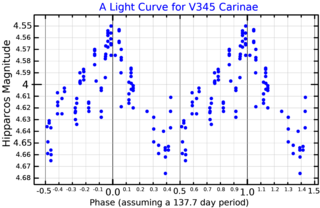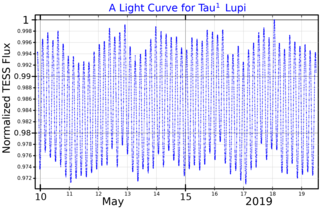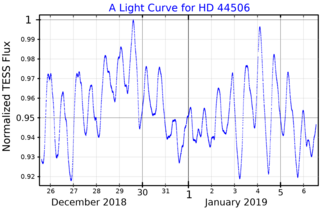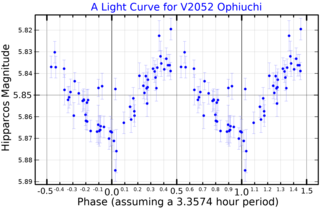
μ Tauri, Latinized as Mu Tauri, is a single star in the equatorial constellation of Taurus. It has a blue-white hue and is faintly visible to the naked eye with an apparent visual magnitude of 4.27. The star is located approximately 490 light years distant from the Sun based on parallax, and is drifting further away with a radial velocity of +16 km/s.

27 Canis Majoris is a binary star system in the northern constellation of Canis Major, located approximately 1,700 light years away from the Sun. It has the variable star designation EW Canis Majoris; 27 Canis Majoris is the Flamsteed designation. This system is visible to the naked eye as a dim, blue-white hued star with an apparent visual magnitude of +4.65. It is moving away from the Earth with a heliocentric radial velocity of 16 km/s.
42 Camelopardalis is a single star in the constellation Camelopardalis, located roughly 770 light years away from the Sun. It is visible to the naked eye as a faint, blue-white hued star with an apparent visual magnitude of 5.14. The visual magnitude of the star is diminished by an extinction of 0.22 due to interstellar dust. It is moving further from the Earth with a heliocentric radial velocity of 3 km/s. 42 Camelopardalis has a peculiar velocity of 24.4+1.9
−2.1 km/s and may be a runaway star.

V337 Carinae is a K-type bright giant star in the constellation of Carina. It is an irregular variable and has an apparent visual magnitude which varies between 3.36 and 3.44. It is easily visible to the naked eye, except in brightly-lit urban areas.

Chi Carinae, Latinised from χ Carinae, is a star in the southern constellation of Carina. It is a third-magnitude star and is one of the brighter members of the constellation. The distance to the star can be determined directly through parallax measurements, yielding an estimate of roughly 450 light-years with a 6.7% margin of error. This star is a suspected astrometric binary, although nothing is known about the companion.

V343 Carinae is a blue-white star or star system in the southern constellation of Carina. It has the Bayer designation d Carinae, while V343 Carinae is a variable star designation. The star is visible to the naked eye with an apparent visual magnitude of 4.31. The distance to this object is approximately 1,440 light years based on parallax. It is drifting further away with a radial velocity of +13 km/s.
HD 91942 is a single variable star in the constellation Carina. It has the Bayer designation r Carinae, while HD 91942 is the identifier from the Henry Draper catalogue. This orange-hued object is visible to the naked eye with an apparent visual magnitude of 4.45. Based on parallax measurements, it is located at a distance of approximately 1,180 light years from the Sun. The star has an absolute magnitude of −3.77, and is drifting further away with a radial velocity of +9.9 km/s.

V520 Carinae is a single star in the southern constellation of Carina. It has the Bayer designation w Carinae, while V520 Carinae is a variable star designation. The star has an orange hue and is faintly visible to the naked eye with an apparent visual magnitude that fluctuates around +4.58. It is located at a distance of approximately 1,140 light years from the Sun based on parallax, and it is drifting further away with a radial velocity of +9 km/s. It is a candidate member of the IC 2391 moving group of co-moving stars.

V345 Carinae is a star in the constellation Carina. It has the Bayer designation E Carinae; V345 Carinae is the variable star designation. The star has a blue-white hue and is faintly visible to the naked eye with an apparent visual magnitude that fluctuates around +4.66. Its actual brightness varies from magnitude +4.67 to +4.78 with a period of 137.7 days. Based on parallax measurements, it is located at a distance of approximately 1,010 light years from the Sun. It is drifting further away with a radial velocity of around +19 km/s.

V376 Carinae is a binary star system in the southern constellation of Carina. It has the Bayer designation b1 Carinae; V376 Carinae is the variable star designation. The system is visible to the naked eye as a faint point of light with a combined apparent magnitude of +4.69. The distance to this system from the Sun is approximately 650 light years based on parallax. It is drifting further away with a radial velocity of +27 km/s.

2 Vulpeculae is a binary star system in the northern constellation of Vulpecula, located around 1,800 light years away from the Sun. It is visible to the naked eye as a faint, blue-white hued star with an apparent visual magnitude of 5.43.
Zeta Circini, Latinized from ζ Circini, is the Bayer designation for a star located in the southern constellation of Circinus. With an apparent visual magnitude of 6.08, it is barely visible to the naked eye on a dark night. The distance to this star, as estimated using an annual parallax shift of 2.56 mas, is around 1,300 light years.

Omega1 Cygni, Latinized from ω1 Cygni, is the Bayer designation for a solitary star in the northern constellation of Cygnus. It is visible to the naked eye with an apparent visual magnitude of 4.94. Based upon an annual parallax shift of 2.59 mas, it is estimated to lie roughly 1,260 light years from the Sun. Relative to its neighbors, this star has a peculiar velocity of 25.7±2.2 km/s.

Tau1 Lupi, Latinized from τ1 Lupi, is a solitary star in the southern constellation of Lupus. It is visible to the naked eye with an apparent visual magnitude of 4.5. Based upon an annual parallax shift of only 2.99 mas as seen from Earth, it is located about 1,090 light years from the Sun. Tau1 Lupi may be a runaway star having a peculiar velocity of 32.6±3.6 km/s. It is a member of the Upper Centaurus–Lupus sub-group of the nearby Sco OB2 association.

HD 54893, often called A Puppis is a suspected variable star in the constellation Puppis. Its apparent magnitude is 4.83 and is approximately 860 light years away based on parallax.

N Scorpii, also known as HD 148703, is a solitary, bluish-white hued star located in the southern constellation Scorpius. It has an apparent magnitude of 4.23, making it readily visible to the naked eye. N Scorpii was initially given the Bayer designation Alpha Normae by Lacaille but it was later moved from Norma to Scorpius. N Scorpii is currently located 550 light years away based on parallax measurements from the Hipparcos satellite and is part of the Upper Scorpius–Centaurus region of the Scorpius–Centaurus association.

12 Lacertae is a wide binary star system in the northern constellation of Lacerta, located roughly 1,260 light years away from the Sun based on parallax. It is visible to the naked eye as a dim, blue-white hued point of light with a baseline apparent visual magnitude of 5.23. The system is drifting closer to the Earth with a mean heliocentric radial velocity of –12.5. It is a probable member of the I Lacertae OB association.

HD 44506 is a solitary, blue hued star located in the southern constellation Columba. The object is also called HR 2288, which is its Bright Star Catalog designation. It has an average apparent magnitude of 5.52, making it faintly visible to the naked eye under ideal conditions. HD 44506 is located relatively far at a distance of 1,800 light years based on Gaia DR3 parallax measurements but is receding with a heliocentric radial velocity of 54 km/s.

V2052 Ophiuchi, also known as HR 6684, is a star about 920 light years from Earth in the constellation Ophiuchus. It is a 5th-magnitude star, making it faintly visible to the naked eye of an observer far from city lights. V2052 Ophiuchi is a Beta Cephei variable star, varying slightly in brightness from magnitude 5.81 to 5.84 over a period of about 3.4 hours.

HR 2501, also known as HD 49131 and HP Canis Majoris, is a star about 2,000 light years from the Earth, in the constellation Canis Major. It is a 5th magnitude star, so it will be faintly visible to the naked eye of an observer far from city lights. It is a variable star, whose brightness varies from magnitude 5.35 to 5.80 on a variety of timescales ranging from hours to hundreds of days.

















